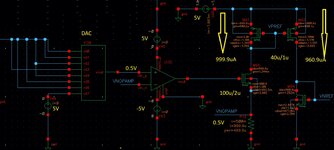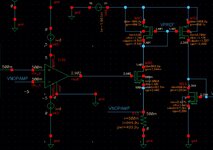noor84
Member level 5
Hi all,
Please, I am going to design the current mirror as in the circuit shown in the attached picture, I have a problem with my circuit that is:
I can not get the same current in the other branch as shown in the picture.
Could you please help me to solve this problem?
Note: the dimensions of W and L for the transistors are shown and I selected them based on trial and error to get these results. Is there any rule to follow to select the best transistor dimensions?
Regards.
Please, I am going to design the current mirror as in the circuit shown in the attached picture, I have a problem with my circuit that is:
I can not get the same current in the other branch as shown in the picture.
Could you please help me to solve this problem?
Note: the dimensions of W and L for the transistors are shown and I selected them based on trial and error to get these results. Is there any rule to follow to select the best transistor dimensions?
Regards.

